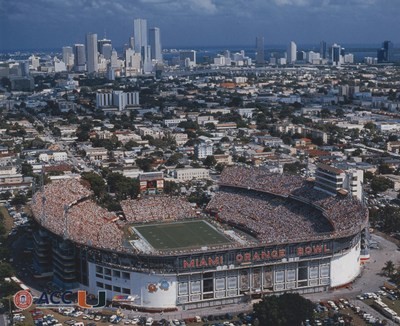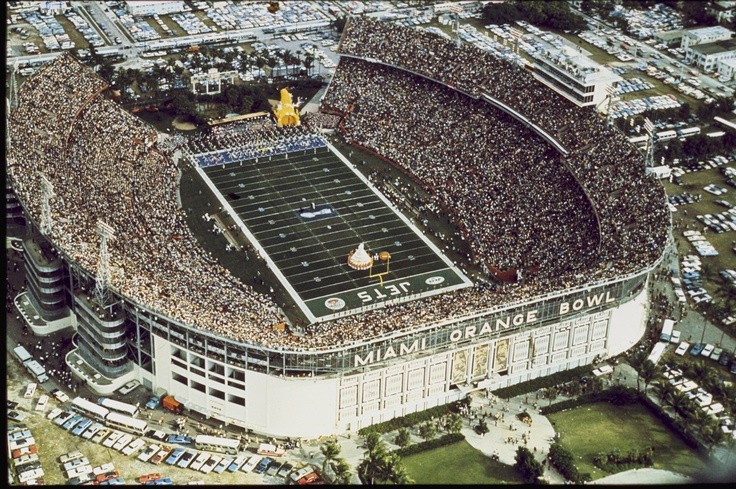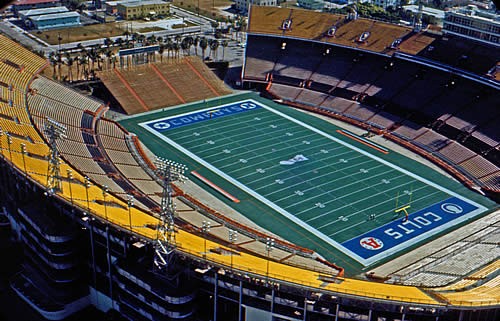Miami Orange Bowl (1937-2008)
Introduction
Text-to-speech Audio
The Orange Bowl was an American Football stadium located in the Miami neighborhood of Little Havana. Construction crews broke ground on the stadium in 1936 and it opened in late 1937. The Orange Bowl was home to many tenants during its 71-year run, but its most notable tenant was the Miami Hurricanes. The stadium also played host to the Orange Bowl Game from 1938 to 1995 and one more time in 1999. Although the city offered to pay over $2000 million to renovate the aging stadium, the university made the decision to move their home games to the city's NFL stadium. Without a regular tenant, the stadium was closed and the structure was demolished in 2008. The Miami Marlins now play at the Orange Bowl's former location in a brand new ballpark designed for baseball.
Images
A downtown view of the Miami Orange Bowl on a college football Saturday.

Super Bowl III was the second consecutive Super Bowl that the Miami Orange Bowl hosted.

The Miami Orange Bowl hosted its third Super Bowl with the fifth iteration of the event.

Backstory and Context
Text-to-speech Audio
When the Orange Bowl opened in 1937, it was named Burdine Stadium. The name change occurred in 1959, when the stadium was renamed the Miami Orange Bowl which was also the name of the college football game bol game the stadium hosted since 1938. The NFL's Miami Dolphins were the primary tenant of the Orange Bowl when they played their first game there in 1966.
In 1968, the Orange Bowl hosted its first Super Bowl. The following year, it hosted the Super Bowl a second time and would later host three more Super Bowls. The stadium also hosted eleven National Championship games. The University of Miami, the stadium's primary tenant from 1987 to 2007, won a total of three National Championships at the Orange Bowl. The Miami Orange Bowl was a symbol of college football, holding over 80,000 spectators. But just as the college football landscape changed, so did the expectations of many season ticket holders and boosters who wanted a stadium that included larger concourses and more luxury suites.
The Miami Hurricanes were a force to be reckoned with in the mid-eighties and nineties, and they won 58 consecutive games at the Orange Bowl. The stadium hosted Olympic soccer matches in 1996. However, the Orange Bowl needed costly renovations to keep up with more modern stadiums, leading to the decision by the Orange Bowl organization to host their annual game elsewhere starting in 1999. The stadium had been an iconic sporting venue and also was home to important historic moments, such as a speech from President Kennedy after the failed Bay of Pigs invasion. After the University of Miami signed a deal to hold their games at the city's NFL stadium, the fate of the Miami Orange Bowl was sealed. The historic venue was demolished in 2008, and the land is now home to the stadium of the Miami Marlins.
Sources
(1) http://www.stadiumsofprofootball.com/past/OrangeBowl.htm (2) http://sports.espn.go.com/ncf/news/story?id=2984425 (3) http://www.hurricanesports.com/ViewArticle.dbml?&DB_OEM_ID=28700&ATCLID=205549026 (4) http://fs.ncaa.org/Docs/stats/football_records/DI/2009/2009Collegiate.pdf
